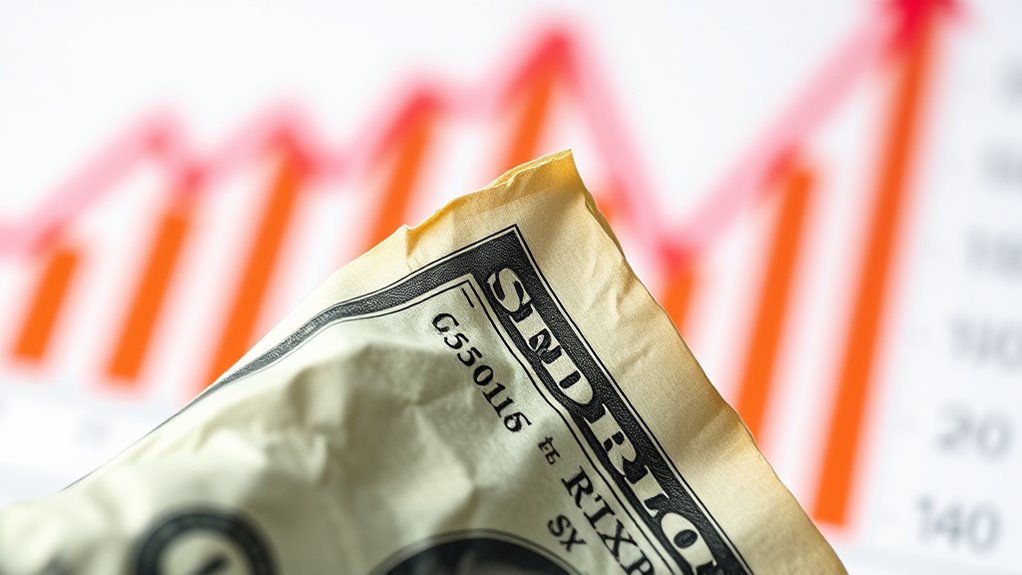Inflation is the silent killer of your retirement savings because it erodes your money’s purchasing power over time. Even if your account balances look healthy in nominal terms, rising prices mean your funds can buy less in retirement. Without inflation protection, your savings may fall short of covering many of your future expenses. Stay informed to discover strategies that can help shield your nest egg from this unseen threat.
Key Takeaways
- Inflation erodes the purchasing power of retirement savings, reducing real value over time.
- Fixed-income investments like bonds often underperform during inflation, risking lower returns.
- Retirees face increased expenses and decreased income, making their savings less effective.
- Without inflation protection, retirement accounts may appear healthy in nominal terms but shrink in real value.
- Incorporating inflation-hedging assets like TIPS and stocks is essential to preserve retirement wealth.

Inflation considerably impacts your retirement savings, eroding the purchasing power of your accumulated funds over time. Even if your account balance shows nominal growth, inflation can quietly diminish its true value, making it harder to maintain your desired lifestyle in retirement. As prices rise, your ability to contribute to retirement accounts may also be hampered because your real income shrinks. When the cost of everyday expenses increases, you might find it tougher to set aside money for the future, forcing you to delay saving or cut back contributions.
Pre-retirement investment strategies that ignore inflation risk leaving you vulnerable. If your investments aren’t adjusted to keep pace with inflation, your future purchasing power will decline, and gains in nominal terms won’t translate into real growth. For example, investments in assets that adjust with inflation, such as stocks and certain inflation-protected securities, can help your retirement savings grow in real terms. Conversely, fixed-income assets like bonds can perform poorly during inflationary periods, especially if they don’t adjust for rising prices. This can lead to lower-than-expected returns, or even losses, which diminish your overall nest egg.
Despite the growth in retirement account participation—rising from 50.5% in 2019 to 54.3% in 2022—and a median balance increase of about 15%, inflation continues to chip away at these gains. By the third quarter of 2024, even with nearly $30 trillion in retirement assets, inflation-adjusted balances fell to roughly $27 trillion, representing a real loss of about $2.5 trillion. This means that your nominal account balance might look impressive, but after accounting for inflation, the actual value shrinks. This inflation risk underscores the importance of diversifying your investments to include assets that can hedge against rising prices. For many, this erosion means they’ll need to work longer—sometimes extending retirement by six years—to compensate for the diminished purchasing power of their savings.
Inflation hits single retirees with less wealth hardest. For example, a single college-educated retiree over 65 might see about $18,000 wiped from their annuity value due to inflation, which could reduce their purchasing power by only $600 relative to their total consumption. Married retirees, however, often face larger nominal losses—around $67,000—yet their total spending decreases only slightly, by about $3,000, thanks to longer life expectancies and other factors. Inflation also increases retirement expenses, forcing you to consider flexible withdrawal strategies that can adapt to rising costs. Adjusting how much you withdraw each year can help preserve your savings and reduce the risk of running out of money.
Finally, it’s important to understand that retirees are more vulnerable to inflation than near-retirees. Since most retirement income sources—apart from Social Security—aren’t fully indexed to inflation, your purchasing power can erode faster. Holding less fixed-rate debt and having higher wealth can provide some cushion, but inflation remains a silent threat. To protect yourself, include inflation-protected securities like TIPS and stocks in your portfolio, and plan for flexible withdrawals to weather the rising tide of costs.
Frequently Asked Questions
How Can I Protect My Retirement Savings From Inflation?
To safeguard your retirement savings from inflation, you should diversify your investments across different asset classes, including inflation-protected securities like TIPS. Consider increasing your contributions to keep pace with rising costs and use retirement planning tools to adjust your strategies regularly. Additionally, seek professional advice and stay informed about market trends. By taking these steps, you can help ensure your savings maintain their purchasing power over time.
Which Investments Are Best for Combating Inflation?
Did you know that during inflationary periods, real estate and commodities have historically doubled or even tripled in value? You should consider investments like real estate, REITs, and commodities because they tend to rise with inflation. These assets help safeguard your purchasing power, providing income and appreciation. Diversifying your portfolio with inflation-protected assets ensures your savings grow even when prices are climbing, securing your financial future.
How Often Should I Review My Retirement Portfolio for Inflation Risk?
You should review your retirement portfolio regularly, especially as you get closer to retirement. Typically, doing this annually is a good start, but if inflation rates are rising or your financial situation changes, more frequent reviews—every six months—are prudent. Keep an eye on inflation trends and adjust your asset allocation accordingly. Regular reviews help make certain your investments stay resilient against inflation’s impact and keep your retirement plans on track.
Does Inflation Affect All Retirement Accounts Equally?
Imagine your retirement savings as a garden; inflation is the relentless drought that shrivels every bloom. It affects all accounts—whether traditional or inflation-protected—by eroding their real value. You might think cash or CDs are safe, but inflation can still diminish their worth. Your best defense is diversifying investments—stocks, bonds, real estate—that can withstand this drought and keep your retirement garden thriving.
What Role Does Inflation Play in Social Security Benefits?
Inflation directly impacts your Social Security benefits by influencing the Cost of Living Adjustments (COLA). When inflation rises, COLAs increase, helping your benefits keep pace with higher prices. Conversely, if inflation slows down, COLAs shrink, potentially reducing your purchasing power. Hence, inflation plays a vital role in maintaining or diminishing the value of your benefits, affecting how well they cover your everyday expenses over time.
Conclusion
Inflation quietly erodes your savings, diminishes your purchasing power, and threatens your retirement dreams. It’s a silent killer that demands your vigilance, your strategies, your action. You must monitor your investments, diversify your assets, and stay informed. Because if you ignore inflation, it will ignore your future. Protect your retirement with awareness, with planning, with purpose. Don’t let inflation be the end of your financial freedom—face it head-on, plan for it, and secure your tomorrow today.










